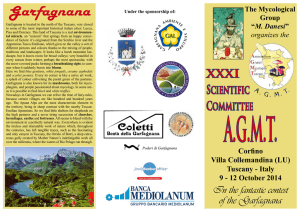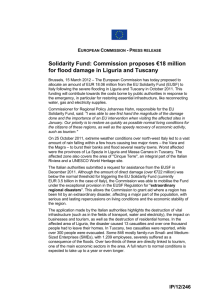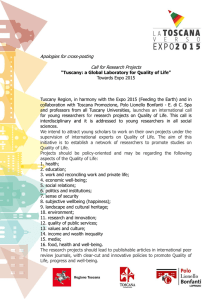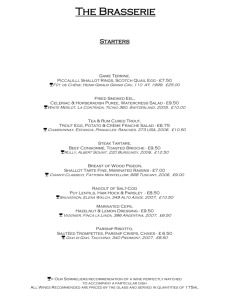`Future` climate and impacts
advertisement
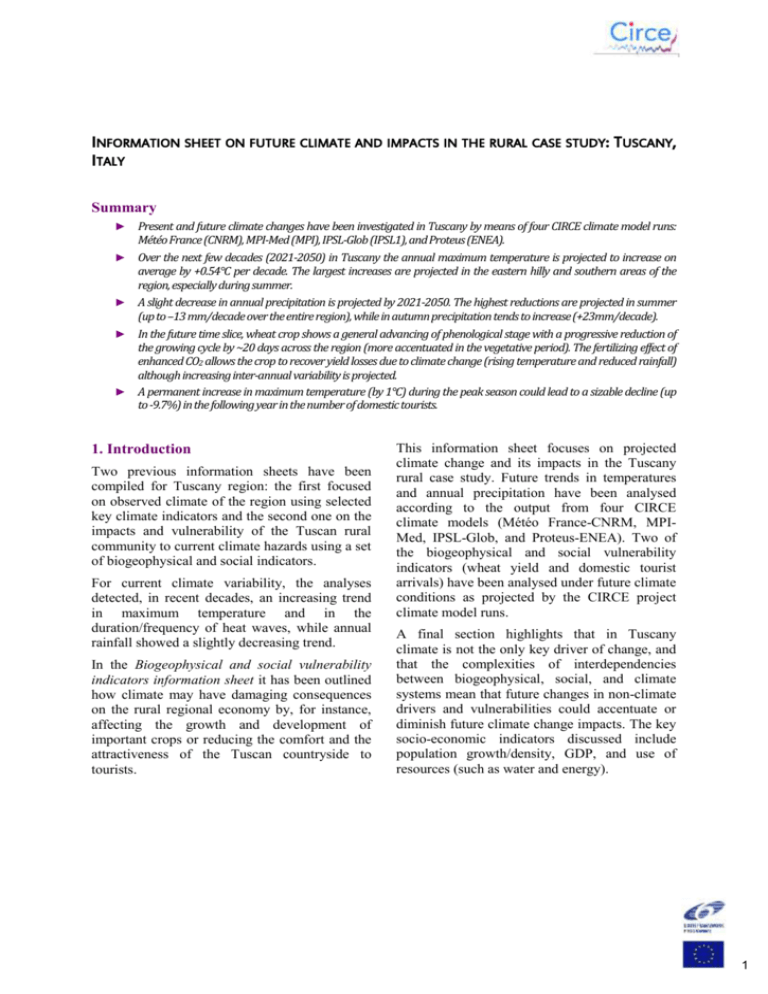
INFORMATION SHEET ON FUTURE CLIMATE AND IMPACTS IN THE RURAL CASE STUDY: TUSCANY, ITALY Summary ► ► ► ► ► Present and future climate changes have been investigated in Tuscany by means of four CIRCE climate model runs: Météo France (CNRM), MPI-Med (MPI), IPSL-Glob (IPSL1), and Proteus (ENEA). Over the next few decades (2021-2050) in Tuscany the annual maximum temperature is projected to increase on average by +0.54°C per decade. The largest increases are projected in the eastern hilly and southern areas of the region, especially during summer. A slight decrease in annual precipitation is projected by 2021-2050. The highest reductions are projected in summer (up to –13 mm/decade over the entire region), while in autumn precipitation tends to increase (+23mm/decade). In the future time slice, wheat crop shows a general advancing of phenological stage with a progressive reduction of the growing cycle by ~20 days across the region (more accentuated in the vegetative period). The fertilizing effect of enhanced CO2 allows the crop to recover yield losses due to climate change (rising temperature and reduced rainfall) although increasing inter-annual variability is projected. A permanent increase in maximum temperature (by 1°C) during the peak season could lead to a sizable decline (up to -9.7%) in the following year in the number of domestic tourists. 1. Introduction Two previous information sheets have been compiled for Tuscany region: the first focused on observed climate of the region using selected key climate indicators and the second one on the impacts and vulnerability of the Tuscan rural community to current climate hazards using a set of biogeophysical and social indicators. For current climate variability, the analyses detected, in recent decades, an increasing trend in maximum temperature and in the duration/frequency of heat waves, while annual rainfall showed a slightly decreasing trend. In the Biogeophysical and social vulnerability indicators information sheet it has been outlined how climate may have damaging consequences on the rural regional economy by, for instance, affecting the growth and development of important crops or reducing the comfort and the attractiveness of the Tuscan countryside to tourists. This information sheet focuses on projected climate change and its impacts in the Tuscany rural case study. Future trends in temperatures and annual precipitation have been analysed according to the output from four CIRCE climate models (Météo France-CNRM, MPIMed, IPSL-Glob, and Proteus-ENEA). Two of the biogeophysical and social vulnerability indicators (wheat yield and domestic tourist arrivals) have been analysed under future climate conditions as projected by the CIRCE project climate model runs. A final section highlights that in Tuscany climate is not the only key driver of change, and that the complexities of interdependencies between biogeophysical, social, and climate systems mean that future changes in non-climate drivers and vulnerabilities could accentuate or diminish future climate change impacts. The key socio-economic indicators discussed include population growth/density, GDP, and use of resources (such as water and energy). 1 2 Future climate Climate models The CIRCE project climate model runs (Gualdi et al., 2011) are used to investigate present and future climate changes in Tuscany. The models adopted in this analysis are: Météo France (CNRM), MPIMed (MPI), IPSL-Glob (IPSL1), and Proteus (ENEA) with a spatial resolution ranging from 25 km (MPI) to 50 km (CNRM). The analysis was performed using only grid cells whose centroid overlays the land surface of the region (Figure 1). Data consist of daily values of temperature and precipitation covering the period 1961–2050. Beyond the year 2000, the SRES A1B emissions scenario (Nakićenović et al., 2000) is applied in all models. The Mann-Kendall test (Mann, 1945; Kendall, 1975) was used to assess the statistical significance of trends. Figure 1: Centroids of CIRCE climate models (CNRM, IPSL1, MPI, and ENEA) used in the analysis of the Tuscany case study. 2 Maximum Annual Temperature What is it? Figure 2 shows annual maximum temperatures in Tuscany simulated by the four CIRCE models (CNRM, ENEA, MPI and IPSL1), for the period 1961-2050. The black line represents the ensemble mean. The green line represents the observed values of annual maximum temperature derived from the E-OBS data set for the period 1961-2009 (Haylock et al., 2008). Table 1 presents the ensemble mean values and trends simulated by the models for the present climate (1961-1990) and the mid-century (2021-2050) as well as the differences between these periods. Figure 2: Annual maximum temperature simulated by ENEA, IPSL1, MPI and CNRM averaged over the Tuscany region for the period 1961-2050. The black line is the average of the four simulations (CNRM, ENEA, MPI, and IPSL1). The green line represents present-day values derived from E-OBS for the period 1961-2009. What does this show? Annual maximum temperature is projected to increase in the next decades by all four models (Figure 2). During the period 1961-1990, annual observed (E-OBS) maximum temperatures ranged from 16.2°C to 18.4°C. Similar values are hindcast by ENEA and MPI, while IPSL1 and CNRM substantially underestimate observations by ~4°C. In the last 20 years (19902009), MPI and ENEA projections slightly underestimate (~1°C) E-OBS data. In the future period, all models project a steep increase in annual maximum temperature that is statistically significant (p<0.05) over the entire region. On average, the increase is +0.54°C per decade during the period 2021-2050. The highest increasing trends are projected by MPI and ENEA (+0.71 and +0.58°C/decade, respectively). The greatest warming is mainly located over the eastern hilly areas (CNRM, ENEA and MPI) and the south (IPSL1) of the region, and during the summer (on average +0.8°C/decade) over the entire region. 3 Table 1: Mean values and trends of the key temperature variables in Tuscany, for the present (1961-1990) and mid-century (2021-2050) periods, calculated as an ensemble mean of the four CIRCE climate models (ENEA, IPSL1, CNRM and MPI). Long term changes were calculated as the difference between mid-century and present values. Inter-model ranges are shown as the standard error between estimates from the four models. The spatial distribution is briefly described in the column ‘Spatial/seasonal location’. Variable Present climate (1961-1990) Long-term variation (1961/19902021/2050) Mid-century (2021-2050) Mean (°C) Trend (°C/decade) Mean (°C) Trend (°C/decade) Mean change (°C) 15.3 ± 1.0 +0.01 ± 0.05 17.1 ± 0.9 +0.54 ± 0.06 1.8 ± 0.3 T min 6.2 ± 1.0 +0.04 ± 0.06 7.8 ± 1.0 + 0.45 ± 0.04 1.6 ± 0.3 T mean 10.7 ± 1.0 +0.02 ± 0.05 12.4 ± 1.0 +0.49 ± 0.05 +1.7 ± 0.3 T max Why is it relevant? Higher temperatures combined with droughts are the major climate hazards in a Mediterranean environment. Annual maximum temperature is a key climate indicator for many physiological processes of plants and animals and human activities. Increasing maximum temperature as projected by the CIRCE models for the next mid-century may represent in Tuscany a big Spatial/seasonal location Future Tmax increases over the entire region, but more so in the eastern hilly areas of Tuscany (CNRM, ENEA and MPI) and the south of the region (IPSL1). The lowest increases are projected along the coast by all four models. On average, summers show the highest increases (0.8°C/decade) over the entire region. Major future Tmin increases are concentrated over south-eastern inner areas of the region (CNRM, ENEA and MPI) and along the coast (IPSL1). On average, summers show the highest increases (0.6°C/decade) over the entire region. The highest future Tmean increases are located in the over south-eastern areas (CNRM, ENEA and MPI), and along the coast (IPSL1). On average, summer shows the highest increases (0.7°C/decade) over the entire region. threat on crop production (e.g., wheat, olive, grapevine, fruit and vegetables) and on landscape changes, a key resource for the rural tourism of the region. Moreover, the expected increase in maximum temperatures may reduce the comfort and attractiveness of the Tuscan countryside and agriturismi-farmhouses to tourists. 4 Annual Precipitation What is it? Figure 2 shows total annual precipitation simulated by four CIRCE climate models (CNRM, ENEA, MPI and IPSL1) for the period 1961-2050, averaged over Tuscany. The black line represents the mean of the four models. The green line displays the observed values of annual precipitation derived from the ENSEMBLES project data set (E-OBS) for the time period 1961-2009 (Haylock et al., 2008). 1800 E-Obs 1600 ENEA IPSL1 Annual Precipitations (mm) 1400 1200 MPI CNRM Mean 1000 800 600 400 200 0 Year Figure 2: Annual precipitation simulated by ENEA, IPSL1, MPI and CNRM averaged over the Tuscany region, 1961-2050. The black line is the mean of the four climate model runs. The green line represents the observed values extracted from E-OBS for the period 1961-2009. What does this show? Hindcast data from ENEA and IPSL show similar values and variability as the E-OBS data, while MPI and CNRM tend to underestimate precipitation in 1961-90. Precipitation projections for Tuscany are characterized by considerable inter-annual variability. On average, cumulative precipitation ranges from 740 to 1087 mm in 1961-90 and from 725 to 1037 mm in 2021-2050. Over the entire period (1961-2050), all models simulate slight decreasing trends in annual precipitation (on average 10 mm/decade). In the mid-century, the highest reductions are projected in summer (on average -13mm/decade), mainly concentrated in the eastern areas of the region. In Contrast, in autumn, all the models project increasing trends (on average +23mm/decade) across the region. Why is it relevant? Although small, future variation in precipitation amount and distribution could have widereaching impacts on agriculture and rural activities in Tuscany. These variations can also lead to a considerable reduction in water resource availability with negative impacts on several sectors (e.g., agriculture, industry, tourism.) which rely on the same limited resource. Moreover, seasonal rainfall variability could affect crop management, such as the timing of sowing, fertilization, and harvesting. For instance, the projected increasing trends in autumn may become a serious constraint to farmers during the sowing phases of winter varieties of wheat (one of the main crops of the region). On the other hand, future decreases in summer precipitation are expected to lead to increasing use of irrigation (including crops traditionally rainfed). Moreover, a major exploitation of water resources could reduce the 5 availability and quality of freshwater resources. Finally, rural tourism could also be seriously be threatened by drier and warmer conditions reducing the attractiveness of the rural Tuscan landscape to tourists. 3 Future impacts Wheat Yield What is it? To evaluate the impact of prospected climate change on durum wheat, a mechanistic model (SIRIUS Quality v.1.1, Jamieson et al., 1998) was used to estimate the phenology and the yield of the crop in the future time-slice 2021-2050 under the A1B scenario. SIRIUS model requires as input daily values of min/max temperature, precipitation and radiation. The model outputs were compared with the results of the simulations in the 30-year period 1961-1990 (the reference period). To take into account the uncertainty in climate projections, the simulations were performed using three daily time-step gridded data-sets produced within the CIRCE project, namely ENEA, MPI and IPSL. The analyses were limited to grid points with altitude lower than 700 m.a.s.l. (above which durum wheat is not usually cultivated). A climatic criterion was adopted to identify the optimum sowing date: starting from October 1st and no later than February 15th; sowing was matched when the mean temperature of five consecutive days was 14°C or lower and rainfall was lesser than 2mm. Nitrogen fertilization was set at 90 Kg N ha-1 and split into two applications: 1/3 during tillering and 2/3 at shooting. Figure 5: Box-Whiskers plots of the duration of durum wheat growing cycle (left) and annual yields (right) in the periods 1961-1990 (baseline) and 2021-2050 considering only the effect of climate change (CC) and increased CO2 concentration (CC + CO2) What does this show? Figure 5 represents the distribution of the duration of the growing cycle and of the annual yield, resulting from the ensemble of the SIRIUS simulations using the three CIRCE climate models. Progressive increasing temperatures in the future time-slice results in, a general advancing of phenological stage with respect to the baseline and in a shorter inter-phase time. On average, cropgrowing cycles are progressively reduced by ~ 20 days over the region. In particular, the vegetative period (sowing-anthesis) was shortened by 18 days on average, whereas the reproductive phase (anthesis-ripeness) was less affected (-1.3 days with respect to the baseline). Despite the lower time for biomass accumulation, yields are unchanged, 6 mainly due to the fertilizing effect of enhanced CO2. In fact, without considering the CO2 effect, yield yields are reduced by -6.8%. However, future durum wheat yields tend to be less stable. The interannual variability, expressed as the coefficient of variation (CV) of the annual yield distribution, increased from 8.9% in the baseline to 12.6% in 2021-2050. Why is it relevant? Durum wheat is a rain-fed crop that it is widely cultivated over Tuscany. The major climatic constraints to durum wheat yield under Mediterranean environments are both high temperature and drought that frequently occur during the growing cycle of the crop (Porter and Semenov, 2005; García del Moral et al., 2003). As a consequence, the projected climate changes for this region, in particular rising temperatures and decreasing rainfall, may seriously compromise durum wheat yields, thus representing a serious threat to the cultivation of this typical crop. A shortened growing season may be counterbalanced by enhanced radiation and water-use efficiency derived from increased CO2 air concentration. However, even though not significant, the increased inter-annual variability in yield could represent a threat for farmers’ income and could induce them to substitute the crop with more stable ones. Domestic tourist arrivals What is it? Figure 4 shows the marginal effect of a temporary increase in maximum summer temperature reported by Cai et al. (submitted) who investigated the empirical impact of climate conditions on tourist flows in Tuscany. This study relies on an eight-year panel dataset with a high degree of spatial disaggregation (Tuscany’s 254 municipalities), to analyse how international and domestic tourist inflows are affected by weather conditions at key times of the year. The analysis focused on maximum temperature (which is more likely to be perceived by tourists) at key time of tourist season (from June to September, Regione Toscana, 2008) applying two types of econometric setups: fixed effects estimation of a static specification and system GMM (Generalized Method of Moments; Wooldridge, 2002) estimation of a dynamic model. The first model assesses the potential effects of climate change on tourism flows to Tuscany based on observing how the two have varied in a set of destinations. The dynamic version of the model was applied to compute both the short-term and long-term elasticity of tourist inflows to changes in climatic conditions. Figure 4: Marginal effect of a temporary increase in maximum summer temperatures on domestic tourist arrivals with 95% confidence intervals. The predicted change in tourist arrivals is expressed on a logarithmic scale (Y axis). The independent variable is represented by the number of years after year t. 7 What does this show? Domestic tourist inflows are quite responsive to variation in the climate variables, while international tourist arrivals seem substantially insensitive to those variables. These two types of visitors may seek different kinds of attractions, and enjoy different degrees of flexibility in adjusting their travel arrangements in response to climate information. Figure 4 shows the marginal effect of a temporary increase in maximum summer temperature on domestic tourist arrivals using the dynamic econometric model application. Applying the static model, a 1°C increase in summer Tmax has no significant effect on domestic tourist arrivals in the current year, but gives a statistically significant (p<0.05) reduction of 9.7% (95% confidence interval: ± 7.5%) in the following year. Conversely, applying the dynamic model, if maximum temperatures are higher by 1ºC on average in the summer of year t and subsequently revert to their initial value in each of the following years, this reduces domestic tourist arrivals by 3.4% in year t, 7% in year t + 1, and 4.2% in year t + 2, and 2.5% in year t + 3 (Figure 4). 4. Socio-economic trends In Tuscany, climate is not the unique driver of change: interdependences among biogeophysical – social – economic patterns are very complex and these interactions may alter (accentuating or diminishing) the future vulnerability of the system due to climate change impacts. Tuscany is one of twenty Italian administrative regions (the fifth in order of size), with a population of 3,677,048 inhabitants over 22,992 km2. The population density is thus about 160 persons/ km2, slightly lower than the national average. More than 50% of the regional population is concentrated in cities located along the Arno River basin. Despite a relatively constant decline in the birth rate from the seventies onwards, the population was quite stable until the end of the nineties. The increase in immigration rates, both from southern Italian regions and from foreign countries (in particular Eastern Europe and Africa), has produced a significant population increase in the last 10 years (+5.1%) representing the main driver of population growth. Currently, foreigners represent 4.6% of the total population and this percentage is projected to reach 12% by 2020. The Tuscany GDP (96,890 Million Purchasing Standards -as in Eurostat- €27,400.00 per capita) Why is this important? The importance of climate as a factor in tourist destination choice has been widely acknowledged (Scott et al., 2005). Many studies (Scott et al., 2004; Hamilton et al., 2005; Amelung et al., 2007) state that the projected climate change will likely shift tourism flows toward higher latitudes and altitudes. The direction of impact on tourist flows to Tuscany of such climate modifications is not that clear. It is conceivable that, even as maximum temperatures rise above the levels perceived by tourists as comfortable, visitation rates to key historic and cultural destinations may not be affected much. At the same time, it seems plausible that most other parts of the region may exhibit the same type of vulnerability to climate change as in many Mediterranean regions (Perry 2000; Amelung and Viner, 2004). In this context, the increasing occurrence of extreme climate events, such as heat waves, have the potential to significantly reduce tourism flows to Tuscany, with outstanding consequences for the Tuscan tourism industry which accounts for 8% of regional GDP (Regione Toscana, 2010). was 6.72 % of the national GDP in 2006 and 0.83% of the EU. The sector contribution to GDP in Tuscany is shown in Figure 5. The import/export balance for Tuscany is +€4,967 million. Figure 5: Composition of GDP for Tuscany (source ISTAT) Water resources in Tuscany are currently sufficient to meet the region’s demand. Currently, water consumption is allocated as follows: 45% for households, 34% for the secondary sector, and 21% for agriculture and livestock. Analysis of the trend in the recent years indicates a continuous increase. This fact, coupled with the projected climate change 8 impacts for the Tuscany region, will likely lead to a conflict of interests on the water resources from the different sectors, which reveals the need to deal with water resources management. The Tuscany region is characterized by a hilly and mountainous landscape and by a lack of significant surface water (rivers, reservoirs) for agriculture irrigation. Traditionally the farming system is consolidated mainly by crops, which are well adapted to specific soil and climate conditions. Variation in climate conditions might likely lead to a reduction of crop yields which typically characterize the Tuscan landscape. Water should be carefully managed, avoiding waste and increasing efficiency in all sectors, in order to preserve a globally fundamental resource. The energy demand in Tuscany increases by +2% yearly, with a subsequent increase in energy deficit (currently around 12%). In 2004 the total Tuscan consumption was 21,000 Gwh (35% by the industrial sector, 32% by household sector, 31.5% by the transport sector and 1.5% y the agricultural sector), while the local production was around 19,000 Gwh. Interestingly, 28% of the energy produced in Tuscany is geothermal (thus renewable). 30% of energy consumption is from renewable sources, mainly hydroelectric. 77% is produced by thermoelectric power plants, in particular using oil (even if the conversion to a combined cycle with methane has been recently started). The regional law No. 39 of 2005 regarding the energy sector, followed by the Regional Energetic Plan (PIER, Piano di Indirizzo Energetico Regionale), designed a new energy policy for Tuscany, with €109 million invested to have, by 2020, 39% locally produced electricity, and 10% thermal energy from renewable sources, reducing CO2 emissions by 7.2 million tons. 5. Uncertainties There are uncertainties present in all stages of CIRCE case-studies, from observations, to emissions, models, projections, impacts and adaptive response. The main novelty of the CIRCE project is the inclusion of a realistic representation of the Mediterranean Sea in the climate models. To reduce the uncertainties related to climate projections a multi-model approach was undertaken. Four climate models (Météo France-CNRM, MPIMed, IPSL-Glob, and Proteus-ENEA) developed within the CIRCE project were used to assess climate changes and impacts in Tuscany. Although variability is present among models, all the models show similar trends in future projections, depicting progressive warming and drying conditions for the region (see previous sections). Some uncertainties persist concerning the pattern of change across the region. For instance, despite a substantial consensus among three out of four models (CNRM, ENEA and MPI), IPSL1 shows different spatial distribution of future temperature increases (see Table 1). Another source of uncertainty is the impact models used. For instance, crop growth models, although mechanistic, may contain many simple empiricallyderived relationships that do not completely represent actual plant processes. Several aspects, such as weeds, pests, extreme climate events and soil conditions (i.e., salinity or acidity) are not considered or scarcely controlled for, representing another source of uncertainty. Exploring such uncertainties, considering the use of several impact models, should be taken into account for future investigations. Concerning tourism, the model estimates the "causal" effect of an average change in temperature on tourism arrivals. Although summer Tmax is related to extreme events that may greatly affect tourist comfort, such as heat waves, very hot days/nights, these latter are not directly taken into account. It is clear that the approach applied is better suited for estimating the direct effect (i.e., attractiveness of the destination due to ‘good’ or ‘bad’ weather) of varying climatic conditions than for evaluating their indirect consequences, such as those emerging through changes in amenities (Simpson et al., 2008). For this reason, further research should also consider indirect effects, such as a decline in landscape attractiveness or reduced water resources for tourism (e.g., swimming pools, drinking water) and also for seasonal changes in behavior of tourists (e.g., a shift from peak summer season to shoulder seasons, or the potential benefits of a lengthening of the summer season). In addition, future work could consider the relative attractiveness of specific areas of the region, since coastal areas are projected to be affected by a lower rate of temperature increases with respect to inland ones. 6. Integrated assessment Table 2 summarizes climate trends and changes in the Tuscany rural case study based on the ensemble of four CIRCE models for the present climate 9 (1961-1990) and the mid-century (2021-2050) periods. In the next few decades, the expected increase in temperature, hot days/nights and heat waves may have serious consequences for many environmental processes and for human health and therefore will likely make the system more vulnerable with respect to the present. The considerable inter-annual variability in precipitation continues to affect crop management practises in agriculture (e.g., sowing and harvesting) as well as crop yields and yield quality. The decreasing trends of precipitation expected in the mid-century are not very high, but are mainly concentrated in the summer season, lowering the availability and quality of freshwater resources which could cripple several sectors (e.g., tourism and agriculture). when the fertilizing effect of increased CO2 concentration is also considered. On the other hand, notable impacts are expected for tourism: the reduction of annual domestic tourist arrivals related to increases of summer Tmax could likely affect the tourism economy of the region. Moreover, the projected longer-lasting and more frequent hot days/night and heat waves may in the next decades cause considerable disruption of human activities with negative social, economic and environmental effects. On this basis, policy makers are strongly recommended to develop appropriate efficient short/long-term strategies to cope with the expected impacts of future climate on Tuscany that have been highlighted throughout the CIRCE project. Wheat, one of the main crops of Tuscany, shows no relevant future trend due to variation in climate Acknowledgements CIRCE (Climate Change and Impact Research: the Mediterranean Environment) is funded by the Commission of the European Union (Contract No 036961 GOCE) http://www.circeproject.eu/. This information sheet forms part of the CIRCE deliverables D11.4.5. References ► ► ► ► ► ► ► ► ► ► ► ► ► Amelung, B. and D. Viner. 2004. The vulnerability to climate change of the Mediterranean as a tourist destination. In: Amelung, B., K. Blazejczyk and A. Matzarakis (eds.), Climate change and tourism. Assessment and coping strategies, pp. 41–54 Amelung, B., S. Nicholls and D. Viner. 2007. Implications of global climate change for tourism flows and seasonality. Journal of Travel Research 45: 285–296 Cai M., Ferrise R., Moriondo M., Nunes P.A.L.D., Bindi M., Submitted. Climate change and tourism in Tuscany, Italy. Some can’t stand the heat. Climate Change Economics. Garcia del Moral L.F., Rharraabti Y., Villages D. and Royo C. 2003. Evaluation of grain yield and its components in durumwheat under Mediterranean conditions: An ontogenic approach. Agron. J. 95: 266–274 Gualdi S., Somot S., May W., Castellari S., Déqué M., Adani M., Artale V., Bellucci A., Breitgand J.S., Carillo A., Cornes R., Dell’Aquilla A., Dubois C., Efthymiadis D., Elizalde A., Gimeno L., Goodess C.M., Harzallah A., Krichak S.O., Kuglitsch F.G., Leckebusch G.C., L’Heveder B.P., Li L., Lionello P., Luterbacher J., Mariotti A., Nieto R., Nissen K.M., Oddo P., Ruti P., Sanna A., Sannino G., Scoccimarro1 E., Struglia M.V., Toreti1 A., Ulbrich U., and Xoplaki E. 2011. Future Climate Projections. In Regional Assessment of Climate Change in the Mediterranean. A. Navarra, L.Tubiana (eds.), Springer, Dordrecht, The Netherlands. Hamilton, J. M., D. J. Maddison and R. S. J. Tol. 2005. Effects of climate change on international tourism. Climate Research 29: 245–254 Haylock, M. R., N. Hofstra, A. M. G. Klein Tank, E. J. Klok, P. D. Jones, and M. New. (2008). A European daily high resolution gridded data set of surface temperature and precipitation for 1950–2006, J. Geophys. Res., 113, D20119, doi:10.1029/2008JD010201 Jamieson P.D., Semenov M.A., Brooking I.R., Francis G.S. 1998. Sirius: a mechanistic model of wheat response to environmental variation. European Journal of Agronomy 8: 161–179 Kendall, M. G., 1975. Rank Correlation Methods, Charles Griffin, London, UK. Mann, H. B., 1945. Nonparametric tests against trend, Econometrica, 13, 245– 259. Nakićenović, N., and R. Swart (eds.) 2000. Special Report on Emissions Scenarios. A Special Report of Working Group III of the Intergovernmental Panel on Climate Change. Cambridge University Press, Cambridge, United Kingdom and New York, NY, USA, 599 pp. Perry, A. 2000. Impacts of climate change on tourism in the Mediterranean: adaptive responses. Nota di Lavoro (Working note) FEEM 35.2000 Porter J. R. and Semenov M. A. 2005. Crop responses to climatic variation. Phil. Trans. R. Soc. B 360: 2021–2035. 10 ► ► Regione Toscana. 2010. available at: http://www.regione.toscana.it/turismo/guida/, accessed: June 2010 Scott, D., G. McBoyle and M. Schwartzentruber. 2004. Climate change and the distribution of climatic resources for tourism in North America. Climate Research 27: 105–117. ► Scott, D., G. Wall and G. McBoyle. 2005. The evolution of the climate change issue in the tourism sector. In: J. E. S. Higham (ed.), Tourism, recreation and climate change, Chapter 3, pp. 44–60. ► Simpson, M.C., Gössling, S., Scott, D., Hall, C.M. and Gladin, E. 2008. Climate Change Adaptation and Mitigation in the Tourism Sector: Frameworks, Tools and Practices. UNEP, University of Oxford, UNWTO, WMO: Paris, France. ► Wooldridge, Jeffrey M. 2002. Econometric Analysis of Cross Section and Panel Data (Cambridge, MA: MIT Press) Author: Camilla Dibari (camilla.dibari@unifi.it)1, Roberto Ferrise (roberto.ferrise@unifi.it)1, Marco Bindi (marco.bindi@unifi.it)2 1 Department of Plant, Soil and Environmental Science, University of Florence, Italy, 2IBIMET_CNR, Florence, Italy; Editors: Maureen Agnew (m.agnew@uea.ac.uk) and Clare Goodess (c.goodess@uea.ac.uk), Climatic Research Unit, School of Environmental Sciences, University of East Anglia, Norwich, UK Date: July 2011 Table 2: Summary of annual trends and changes in Tuscany for the present 1961-1990 and the mid-century 20212050 periods based on a set of numerical simulations. present (1961-1990) Climate Indicator (hazard) trends T mean (°C/decade) +0.0 T max (°C/ decade) +0.0 T min (°C/ decade) +0.0 Precipitation (mm/decade) +5.2 Hot days (n° days/decade) +1.5 Hot nights (n° days/decade) +2.5 Heat waves (n° of days/decade) Wheat Yield (ton/ha/decade) Domestic tourist arrivals impact no significant change no significant change no significant change small increase no significant no significant change no significant change mid-century (2021-2050) Trends long-term (1961-1990 to 2021-2050) changes impact +0.5 +1.7 °C air warming +0.5 +1.7 °C day air warming +0.4 +1.6 °C night air warming -4.4 -64.3 mm Increase in water resource competition +8.1 +27 days Increase in number of very hot days +8.9 +33 days Increase in number of very hot nights +0.0 no significant change +8.6 No trend no significant change No trend 1ºC increase in summer Tmax temperatures reduces annual arrivals of tourists originating from Italy by 9.7% (95% confidence interval: ± 7.5%) in the following year +26.8 days - Significant (p<0.05) Increase in maximum number of consecutive days with Tmax higher than long-term (19611990) Tmax 90th percentile. Stable wheat yield considering the effect of climate change with increased CO2 concentration Potential reduction in domestic tourist arrivals 11

